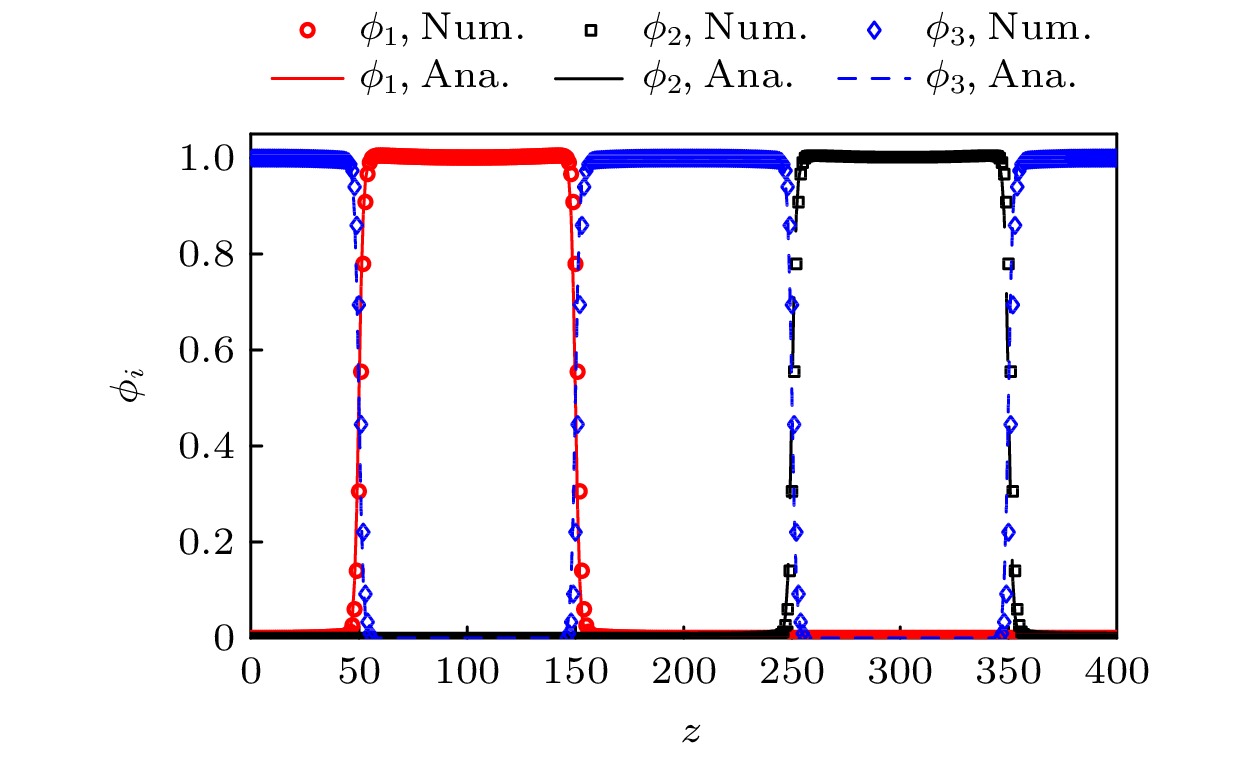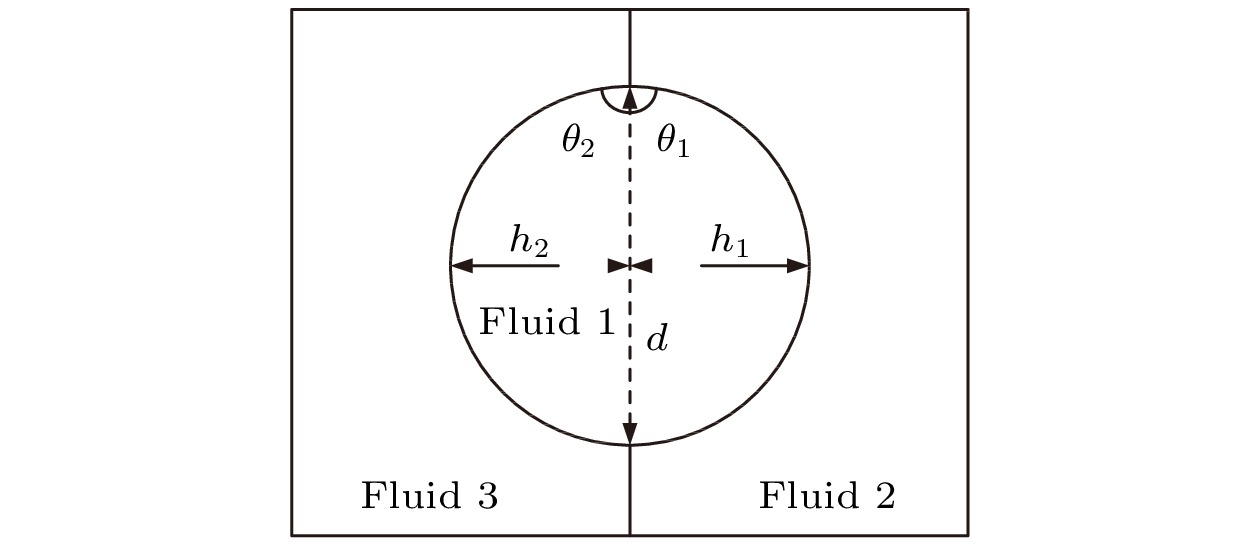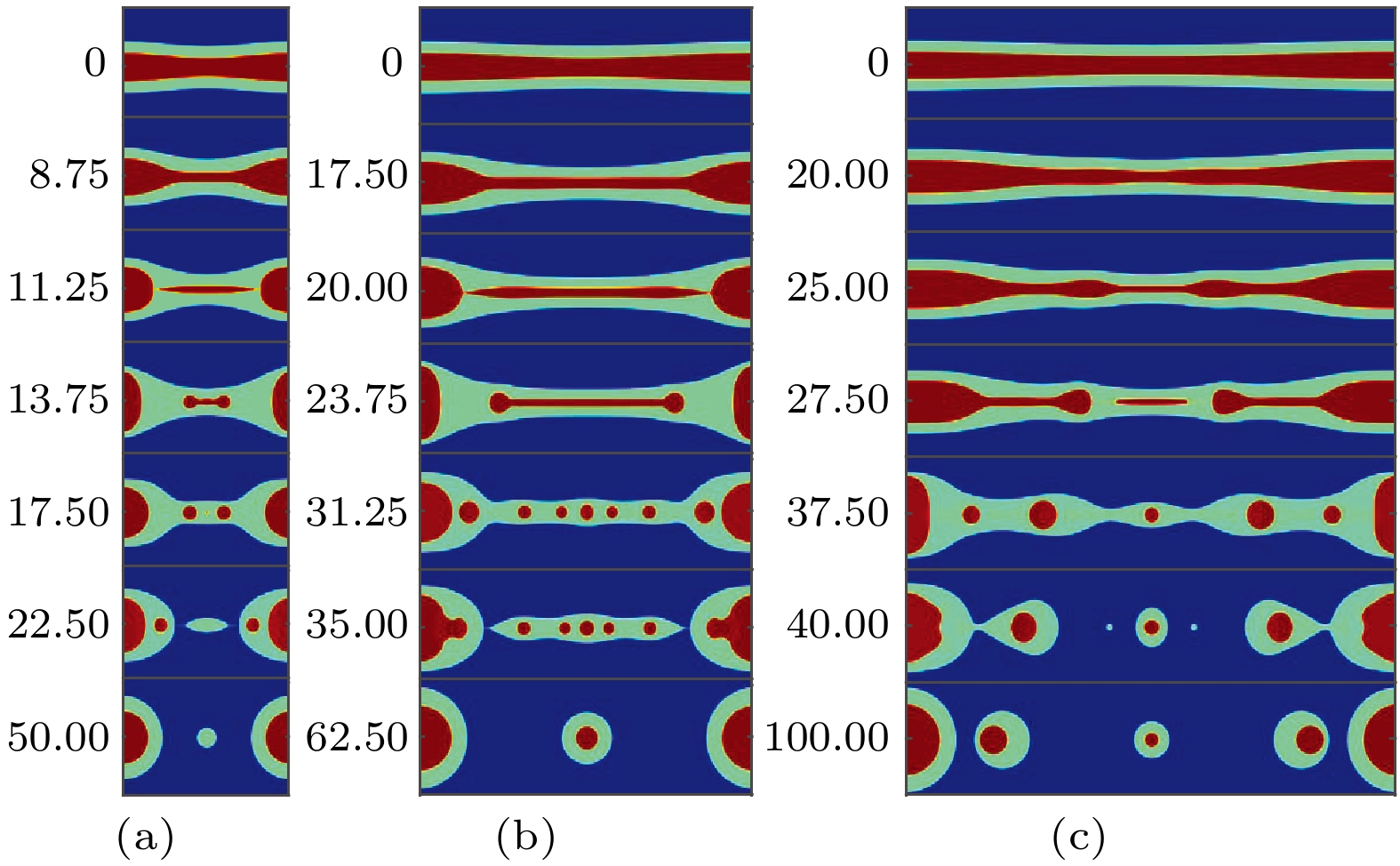-
基于多组分相场理论提出了一类模拟三相流体流动的轴对称格子Boltzmann模型. 该模型利用两个粒子分布函数来捕捉三种不同流体之间的相界面, 另一个粒子分布函数来求解流体动力学方程以获得流场信息. 为了刻画坐标变换引起的轴对称效应, 巧妙地设计了演化方程中平衡态分布函数和外力项分布函数, 从理论上保证本文模型可以正确恢复三相流体系统的宏观控制方程, 并且轴对称效应产生的源项中不包含任何复杂的梯度项, 从而比现有的轴对称格子Boltzmann模型更加简单高效. 首先通过模拟一系列轴对称多相流的基准算例, 包括静态的双液滴、液体透镜的扩展和二元流体Rayleigh-Plateau不稳定性, 来验证本文模型的有效性与正确性. 接下来, 利用该模型研究了三相流体的Rayleigh-Plateau不稳定性的增长过程, 定量分析了波数和液柱半径比对复合液体线程破裂过程中界面动力学行为、界面破裂时间以及生成子液滴尺寸的影响. 可以发现复合的液体线程在波数较大时破裂生成一个复合主液滴和卫星液滴, 而在波数较小时可以生成更多数量的卫星液滴, 这导致复合主液滴和卫星液滴的尺寸随着波数的增加呈现先增大而后减少的趋势. 另外, 我们发现内部流体优先于中间流体发生界面破裂, 并且流体界面的破裂时间均随着波数的减小而增加. 最后发现, 增大液柱半径比可以促进内部液体线程的破裂, 而延缓中间液体线程发生破裂, 并且复合主液滴的尺寸随着液柱半径比的增加而增大, 而复合卫星液滴的尺寸对液柱半径比的变化不显著.
-
关键词:
- 格子Boltzmann方法 /
- 轴对称 /
- 三相流 /
- Rayleigh-Plateau不稳定性
Based on the multi-component phase field theory, in this paper we propose an axisymmetric lattice Boltzmann model for three-phase fluids. The proposed model takes advantage of two particle distribution functions for capturing phase interface among three different fluids, and another particle distribution function for solving the hydrodynamic equations for flow field. In order to describe the axisymmetric effect arising from the coordinate transformation, we elaborately design the equilibrium distribution function and forcing distribution function in the evolution equation, which ensures that the model can accurately recover the macroscopic governing equation for three-phase fluids. Also, the introduced source terms accounting for the axisymmetric effect contain no additional gradient term, which makes it be simpler than the existing lattice Boltzmann model for axisymmetric three-phase fluids. To validate the proposed model, a series of axisymmetric multiphase benchmark examples are performed, including the static double droplets, the spreading of liquid lens, and the binary-fluid Rayleigh-Plateau instability. It is reported that the present model can accurately capture the phase interface, and the predicted steady shapes of the liquid lens agree well with the analytical profiles. Then, the proposed model is used to study the three-phase Rayleigh-Plateau instability and the effects of the wavenumber and the radius ratio of liquid column on the interfacial dynamic behaviour, the breakup time of liquid threads and the size of daughter droplet are investigated in detail. It can be found that the compound liquid thread at a high wavenumber could break up into one main droplet and one satellite droplet, but the multiple satellite droplets can be produced at a low wavenumber, which leads to that the sizes of main and satellite droplets increase with the wavenumber at first and then decrease with it. Besides, we can observe that the inner fluid undergoes the breakup at earlier time than the middle fluid, and the breakup time for both inner and middle fluids increases with the decrease of the wavenumber. Finally, we can find that increasing the radius ratio of liquid column accelerates the breakup of inner-fluid thread, but prevents the breakup of the middle-fluid thread. In addition, the size of the compound main droplet increases with the radius ratio of liquid column, while the size of the compound satellite droplet doest not change much with it.[1] Smith K A, Solis F J, Chopp D L 2002 Interfaces Free Bound. 4 263
[2] Bonhomme R, Magnaudet J, Duval F, Piar B 2012 J. Fluid Mech. 707 405
[3] Kim J 2007 Comput. Methods Appl. Mech. Eng. 196 4779
 Google Scholar
Google Scholar
[4] Guo Z L, Shu C 2013 Lattice Boltzmann Method and Its Applications in Engineering (Singapore: World Scientific) pp10–32
[5] 胡晓亮, 梁宏, 王会利 2020 69 044701
 Google Scholar
Google Scholar
Hu X L, Liang H, Wang H L 2020 Acta Phys. Sin. 69 044701
 Google Scholar
Google Scholar
[6] 贺传晖, 刘高洁, 娄钦 2021 70 244701
 Google Scholar
Google Scholar
He C H, Liu G J, Lou Q 2021 Acta Phys. Sin. 70 244701
 Google Scholar
Google Scholar
[7] Spencer T J, Halliday I, Care M C 2010 Phys. Rev. E 82 066701
 Google Scholar
Google Scholar
[8] Leclaire S, Reggio M, Trepanier J 2013 J. Comput. Phys. 246 318
 Google Scholar
Google Scholar
[9] Yu Y, Liu H H, Liang D, Zhang Y H 2019 Phys. Fluids 31 012108
 Google Scholar
Google Scholar
[10] Semprebon C, Kruger T, Kusumaatmaja H 2016 Phys. Rev. E 93 033305
 Google Scholar
Google Scholar
[11] Wöhrwag M, Semprebon C, Moqaddam M A, Karlin I 2018 Phys. Rev. Lett. 120 234501
 Google Scholar
Google Scholar
[12] Liang H, Shi B C, Chai Z H 2016 Phys. Rev. E 93 013308
 Google Scholar
Google Scholar
[13] Liang H, Xu J R, Chen J X, Chai Z H, Shi B C 2019 Appl. Math. Model. 73 487
 Google Scholar
Google Scholar
[14] Liang H, Chai Z H, Shi B C, Guo Z L, Zhang T 2014 Phys. Rev. E 90 063311
 Google Scholar
Google Scholar
[15] Haghani-Hassan-Abadi R, Rahimian M 2020 Acta Mech. 231 2323
 Google Scholar
Google Scholar
[16] Yang J X, Li Y B, Lee C Y, Kim J 2021 Eur. J. Mech.-B/Fluid 89 203
 Google Scholar
Google Scholar
[17] Boyer F, Lapuerta C 2006 ESAIM: Math. Model. Numer. Anal. 40 653
 Google Scholar
Google Scholar
[18] Boyer F, Lapuerta C, Minjeaud S, Piar B, Quintard M 2010 Transp. Porous Media 82 463
 Google Scholar
Google Scholar
[19] Jacqmin D 1999 J. Comput. Phys. 155 96
 Google Scholar
Google Scholar
[20] Qian Y, d’Humieres D, Lallemand P 1992 Europhys. Lett. 17 479
 Google Scholar
Google Scholar
[21] Liang H, Shi B C, Guo Z L, Chai Z H 2014 Phys. Rev. E 89 053320
 Google Scholar
Google Scholar
[22] Liang H, Li Y, Chen J X, Xu J R 2019 Int. J. Heat Mass Transfer 130 1189
 Google Scholar
Google Scholar
[23] Rawlinson J S, Widom B 1982 The Molecular Theory of Capillarity (Oxford: Clarendon Press) pp208–214
[24] Jiang F, Tsuji T 2017 Water Resour. Res. 53 11
 Google Scholar
Google Scholar
[25] Zheng L, Zheng S, Zhai Q L 2021 Comput. Fluid 218 104857
 Google Scholar
Google Scholar
[26] Tjahjadi M, Stone H A, Ottino J M 1992 J. Fluid Mech. 243 297
 Google Scholar
Google Scholar
-
图 4 不同界面张力比液体透镜的平衡形态 (a)
$\sigma_{12}:\sigma_{13}: $ $ \sigma_{23}=0.6:0.6:1$ ; (b)$ \sigma_{12}:\sigma_{13}:\sigma_{23}=1:1:1 $ ; (c)$\sigma_{12}: $ $ \sigma_{13}:\sigma_{23}=1:4/3:1$ .Fig. 4. Equilibrium morphology of liquid lens at different interfacial tension ratios: (a)
$ \sigma_{12}:\sigma_{13}:\sigma_{23}=0.6:0.6:1 $ ; (b)$ \sigma_{12}:\sigma_{13}:\sigma_{23}=1:1:1 $ ; (c)$\sigma_{12}:\sigma_{13}:\sigma_{23}= 1:4/ $ $ 3:1$ .表 1 不同表面张力比的液体透镜的平衡接触角
$\theta_1$ 和$\theta_2$ Table 1. Equilibrium contact angles
$\theta_1$ and$\theta_2$ of liquid lens at different surface tension ratios表面张力比
$(\sigma_{12}:\sigma_{13}:\sigma_{23})$数值解 解析解 相对误差 $\theta_1$ $\theta_2$ $\theta_1$ $\theta_2$ $\theta_1$ $\theta_2$ $0.6:0.6:1$ 34.0 34.0 33.6 33.6 1.2% 1.2% $1:1:1$ 60.1 60.1 60 60 0.2% 0.2% $1:4/3:1$ 84.4 49.0 83.6 48.2 1.0% 1.7% 表 2 不同表面张力比液体透镜的长度d和高度
$h_1$ ,$h_2$ Table 2. Length d and heights
$h_1$ ,$h_2$ of liquid lens at different surface tensions表面张力比$(\sigma_{12}:\sigma_{13}:\sigma_{23})$ 数值解 解析解 相对误差 d $h_1$ $h_2$ d $h_1$ $h_2$ d $h_1$ $h_2$ $0.6:0.6:1$ 322.1 49.2 49.2 391.8 59.1 59.1 17.8% 16.8% 16.8% $1:1:1$ 253.0 73.2 73.2 277.0 80.0 80.0 8.7% 8.5% 8.5% $1:4/3:1$ 234.5 106.1 53.4 251.6 112.5 56.3 6.8% 5.7% 5.2% -
[1] Smith K A, Solis F J, Chopp D L 2002 Interfaces Free Bound. 4 263
[2] Bonhomme R, Magnaudet J, Duval F, Piar B 2012 J. Fluid Mech. 707 405
[3] Kim J 2007 Comput. Methods Appl. Mech. Eng. 196 4779
 Google Scholar
Google Scholar
[4] Guo Z L, Shu C 2013 Lattice Boltzmann Method and Its Applications in Engineering (Singapore: World Scientific) pp10–32
[5] 胡晓亮, 梁宏, 王会利 2020 69 044701
 Google Scholar
Google Scholar
Hu X L, Liang H, Wang H L 2020 Acta Phys. Sin. 69 044701
 Google Scholar
Google Scholar
[6] 贺传晖, 刘高洁, 娄钦 2021 70 244701
 Google Scholar
Google Scholar
He C H, Liu G J, Lou Q 2021 Acta Phys. Sin. 70 244701
 Google Scholar
Google Scholar
[7] Spencer T J, Halliday I, Care M C 2010 Phys. Rev. E 82 066701
 Google Scholar
Google Scholar
[8] Leclaire S, Reggio M, Trepanier J 2013 J. Comput. Phys. 246 318
 Google Scholar
Google Scholar
[9] Yu Y, Liu H H, Liang D, Zhang Y H 2019 Phys. Fluids 31 012108
 Google Scholar
Google Scholar
[10] Semprebon C, Kruger T, Kusumaatmaja H 2016 Phys. Rev. E 93 033305
 Google Scholar
Google Scholar
[11] Wöhrwag M, Semprebon C, Moqaddam M A, Karlin I 2018 Phys. Rev. Lett. 120 234501
 Google Scholar
Google Scholar
[12] Liang H, Shi B C, Chai Z H 2016 Phys. Rev. E 93 013308
 Google Scholar
Google Scholar
[13] Liang H, Xu J R, Chen J X, Chai Z H, Shi B C 2019 Appl. Math. Model. 73 487
 Google Scholar
Google Scholar
[14] Liang H, Chai Z H, Shi B C, Guo Z L, Zhang T 2014 Phys. Rev. E 90 063311
 Google Scholar
Google Scholar
[15] Haghani-Hassan-Abadi R, Rahimian M 2020 Acta Mech. 231 2323
 Google Scholar
Google Scholar
[16] Yang J X, Li Y B, Lee C Y, Kim J 2021 Eur. J. Mech.-B/Fluid 89 203
 Google Scholar
Google Scholar
[17] Boyer F, Lapuerta C 2006 ESAIM: Math. Model. Numer. Anal. 40 653
 Google Scholar
Google Scholar
[18] Boyer F, Lapuerta C, Minjeaud S, Piar B, Quintard M 2010 Transp. Porous Media 82 463
 Google Scholar
Google Scholar
[19] Jacqmin D 1999 J. Comput. Phys. 155 96
 Google Scholar
Google Scholar
[20] Qian Y, d’Humieres D, Lallemand P 1992 Europhys. Lett. 17 479
 Google Scholar
Google Scholar
[21] Liang H, Shi B C, Guo Z L, Chai Z H 2014 Phys. Rev. E 89 053320
 Google Scholar
Google Scholar
[22] Liang H, Li Y, Chen J X, Xu J R 2019 Int. J. Heat Mass Transfer 130 1189
 Google Scholar
Google Scholar
[23] Rawlinson J S, Widom B 1982 The Molecular Theory of Capillarity (Oxford: Clarendon Press) pp208–214
[24] Jiang F, Tsuji T 2017 Water Resour. Res. 53 11
 Google Scholar
Google Scholar
[25] Zheng L, Zheng S, Zhai Q L 2021 Comput. Fluid 218 104857
 Google Scholar
Google Scholar
[26] Tjahjadi M, Stone H A, Ottino J M 1992 J. Fluid Mech. 243 297
 Google Scholar
Google Scholar
计量
- 文章访问数: 7440
- PDF下载量: 89
- 被引次数: 0




















 下载:
下载:












































